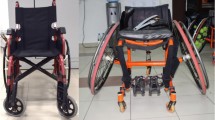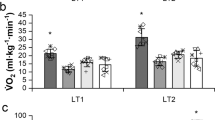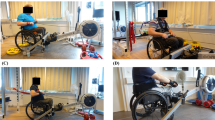Abstract
The purposes of this study were: (1) to compare the physiological responses during simulated wheelchair racing (SR) between male quadriplegics and paraplegics, (2) to test the validity of the SR against a track race (TR) and (3) to examine the relationship between the peak oxygen uptake (peak V02) and wheeling velocity (WV) during the SR and TR. Seven quadriplegics (C5-8 lesions) and six paraplegics (T5-L4 lesions) completed (1) an incremental wheelchair velocity test, (2) a SR (1.6 km for quadriplegics and 3.2 km for paraplegics), and (3) an indoor TR of the same distance. The subjects performed the incremental velocity test and SR in their personal wheelchairs mounted on a roller system interfaced with customized software programmed to provide velocity and distance feedback. Physiological responses were monitored using an automated metabolic cart and electrocardiogram. Blood lactate concentration [La] was determined from finger prick samples. Peak V02 and peak heart rate (peak HR) were significantly higher in the paraplegics compared to quadriplegics: 1.90 ± 0.54 vs 1.07 ± 0.35 l/min, and 188 ± 11 beats/min vs 117 ± 12 beats/min respectively. The paraplegics exercised at significantly (p < 0.05) higher percentages of peak VÓ2 and peak HR during the SR compared to quadriplegics (95% vs 76% and 95% vs 86%, respectively). No significant relationships (p > 0.05) were observed between the peak VÓ2 and WV during the SR and TR in either group. Significant relationships (p < 0.05) were observed between the SR and TR for the race time, WV, HR, and [La] in both groups of subjects. These results suggest: (1) that factors other than peak V02 influence wheelchair racing performance in quadriplegics and paraplegics, and (2) that wheelchair roller racing evaluated in the laboratory is a valid measure of track racing performance in spinal cord injured subjects.
Similar content being viewed by others
Log in or create a free account to read this content
Gain free access to this article, as well as selected content from this journal and more on nature.com
or
References
Cardus D, McTaggart W G, Ribas-Cardas F, Donovan W H (1989) Energy requirements of gamefield exercise designed for wheelchair bound persons. Arch Phys Med Rehabil 70: 124–127.
Coutts K D (1988) Heart rates of participants in wheelchair sports. Paraplegia 26: 43–49.
Shephard R J (1990) Fitness in Special Populations. Human Kinetics Books, Champaign, IL.
Coutts K D, Rhodes E, McKenzie D (1983) Maximal exercise responses of tetraplegics and paraplegics. J Appl Physiol 55: 479–482.
Eriksson P, Lofstrom L, Ekblom B (1988) Aerobic power during maximal exercise in untrained and well-trained persons with quadriplegia and paraplegia. Scand J Rehabil Med 20: 141–147.
Gass G C, Camp E M (1979) Physiological characteristics of trained Australian paraplegic and tetraplegic subjects. Med Sci Sports Exerc 11: 256–259.
Van L oan M D, McCluer S, Loftin J M, Boileau J A (1987) Comparison of physiological responses to maximal arm exercise among able-bodied, paraplegics and quadriplegics. Paraplegia 25: 397–495.
Glaser R M, Davis G M (1989) Wheelchair-dependent individuals. In: Franklin BA, Gordon S, Timmis GC, editors. Exercise in Modern Medicine. Williams & Wilkins, Baltimore, MD: 237–267.
Asayama K, Nakamura Y, Ogata H, Hatada K, Okuma H, Deguchi Y (1985). Physical fitness of paraplegics in full wheelchair marathon racing. Paraplegia 23: 277–287.
Crews D L (1982) Physiological profile of wheelchair marathon racers. Phys Sports Med 10: 243–249.
Lakomy H K A, Campbell I, Williams C (1987) Treadmill performance and selected physiological characteristics of wheelchair athletes. Br J Sports Med 21: 130–133.
Cooper R A (1992) The contribution of selected anthropometric and physiological variables to 10 K performance of wheelchair racers: a preliminary study. J Rehabil Res Dev 29: 29–34.
Hooker S P, Wells C L (1992) Aerobic power of competitive paraplegic road racers. Paraplegia 30: 428–436.
Bhambhani Y, Eriksson P, Steadward R (1991) Reliability of peak physiological responses in spinal cord injured subjects. Arch Phys Med Rehabil 72: 237–242.
Winer B J (1991) Statistical Principles in Experimental Design. McGraw-Hill Book Company, Toronto.
Hjeltnes N (1977) Oxygen uptake and cardiac output in graded arm exercise in paraplegics with low level spinal lesions. Scand J Rehabil Med 9: 107–113.
Bhambhani Y, Singh M (1985) Effects of three training intensities on VO2 max and VE/V02 ratio. Can J Appl Sport Sci 11: 324–318.
Farrell P A, Wilmore J H, Coyle E F, Billing J E, Costill D L (1979) Plasma lactate accumulation and distance running performance. Med Sci Sports Exerc 11: 338–344.
van der Woude L H V, Veeger H E J, Rozendal R H, Van Ingen Schenau G J, Rooth R et al (1988) Wheelchair racing: effects of rim diameter on physiology and technique. Med Sci Sports Exerc 20: 492–500.
Gayle G W, Pohlman R L, Glaser R M (1990) Cardiorespiratory and perceptual responses to arm crank and wheelchair exercise using various handrims in male paraplegics. Res Q Sports Exerc 61: 224–232.
Veeger H E J, van der Woude L H V, Rozendal R H (1991) Wheelchair propulsion technique at different speeds. Scand J Rehabil Med 21: 197–203.
Author information
Authors and Affiliations
Rights and permissions
About this article
Cite this article
Bhambhani, Y., Holland, L., Eriksson, P. et al. Physiological responses during wheelchair racing in quadriplegics and paraplegics. Spinal Cord 32, 253–260 (1994). https://doi.org/10.1038/sc.1994.45
Issue date:
DOI: https://doi.org/10.1038/sc.1994.45
Keywords
This article is cited by
-
The verification phase and reliability of physiological parameters in peak testing of elite wheelchair athletes
European Journal of Applied Physiology (2013)
-
Field-Based Physiological Testing of Wheelchair Athletes
Sports Medicine (2013)



